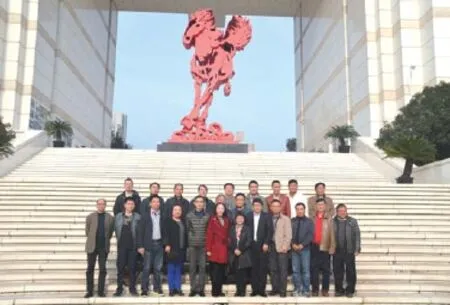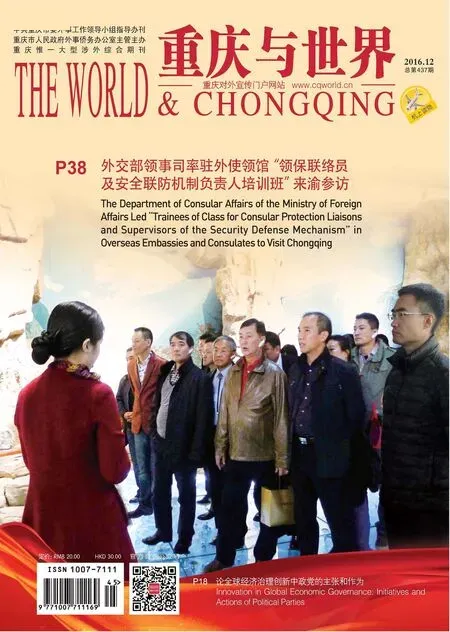外交部领事司率驻外使领馆“领保联络员及安全联防机制负责人培训班”来渝参访
□ 文/本刊记者 胡睿 杨艳
外交部领事司率驻外使领馆“领保联络员及安全联防机制负责人培训班”来渝参访
□ 文/本刊记者 胡睿 杨艳
11月25日至27日,外交部领事司领事保护中心常务副主任、参赞杨舒率首期驻外使领馆领保联络员及安全联防机制负责人培训班来渝进行参观访问。
近年来,境外中国公民安全事件呈多点爆发态势。为深入挖掘驻在国当地资源,有力保护我国公民安全,我驻外使领馆积极试行聘用当地华人华侨作为领保联络员,建立安全联防机制协助开展领事保护与协助工作,加强对当地中国公民的领保力度。这已成为丰富使领馆领事保护与协助工作手段的重要举措,对提高领事工作水平与服务能力具有重要意义。对于“领保联络员”的作用,外交部领事司领保中心常务副主任、参赞杨舒在接受记者采访时称:目前中国公民几乎遍布全世界各个大中城市,而使领馆机构和人员是有限的,因此充分利用民间渠道和力量成为一个新思路和新举措。比如中国公民在海外遭遇突发状况而使领馆工作人员无法第一时间赶到时,就可请联络员尽快到现场了解。一方面缩短了使领馆了解情况的时间,另一方面也可以尽快把政府的关怀传递出去。杨舒特别强调,领保联络员主要由当地的华人华侨组成,不是使领馆的正式工作人员,而是类似于志愿者,为中国公民提供服务。

参观互联网产业园。 摄影:杨艳

重庆市外事侨务办副主任杨大庆(右二)及部分工作人员与外交部领事司领事保护中心常务副主任、参赞杨舒(左二)合影。 摄影:子瑜
在渝期间,在市政府外事侨务办的精心安排下,培训班全体成员通过参观两江新区规划馆、互联网产业园、红岩革命纪念馆、重庆西部物流园等,深入了解了重庆独特的历史文化和改革发展成就,学员们对重庆的对外开放成就和外向型经济发展纷纷赞叹,并对应对海外安全风险提出建议。外交部领事司领事保护中心常务副主任、参赞杨舒还就“2016年中国公民海外安全风险案件的整体情况与特点”“加强海外安全风险防范意识和能力的重要性”等话题接受了本刊记者的专访。

参访团全体成员合影。 摄影:胡睿
From Nov. 25 to 27, 2016, Yang Shu, Counselor and Deputy Director of the Consular Protection Center of the Department of Consular Affairs of the Ministry of Foreign Affairs, led the first group of trainees of class for consular protection liaisons and supervisors of the security defense mechanism in overseas embassies and consulates to visit Chongqing.
In recent years,security events of overseas Chinese citizens have scattered around the rest of world, China’s overseas embassies and consulates had a positive try to employ local Chinese and overseas Chinese as consular protection liaisons and establish a reliable security defense mechanism to assist in the consular protection and other aff airs and strengthen the protection of local Chinese citizens. It has serviced as an important measure for enriching the consular protection and assistance with great significance to improve the level of consular works and service capability. Concerning the role of “consular protection liaison”, Mr. Yang recently told us in a interview, “At present Chinese citizens spread around large and medium-sized cities of the rest of the world, and institutions and personnel of the overseas embassies and consulates are limited, so that civil channels and strength should be fully pooled as a new idea and a new initiative. For example, if a Chinese citizen in a foreign country encounters the emergency situation and the consular staff s can not be on the site the fi rst time, the consular staffs can ask the liaison to be there as soon as possible to know the situation. On the one hand, the time for embassies and consulates to ask for the information will be shortened, and on the other hand, our government's care to them can be passed down as soon as possible. Mr. Yang stressed that consular protection liaisons are mainly composed of local and overseas Chinese instead of the offi cial staff s of embassies and consulates, and their work is similar to volunteers' to provide services for Chinese citizens.
During the visit in Chongqing, in careful and detailed arrangement of the Foreign Affairs Office of Municipal Government, the delegation made an in-depth understanding of Chongqing’s unique history, culture and achievements gained from reform and development by visiting the Planning Museum of the Liangjiang New Area ( Liangjiang means two Chinese rives named Yangtze River and Jialing River), the Internet Industry Park, the Hongyan Revolutionary Memorial Hall, and the West Logistics Park of Chongqing. Trainees all expressed great admiration to achievements gained by the openingup in Chongqing and its export-oriented economic development, and proposed some suggestions on how to deal with overseas security risks. Mr. Yang had an exclusive interview about topics including“The Overall Situation and Characteristics of 2016 Overseas Security Risks of Chinese Citizens” and “The Importance of Improving the Awareness and Ability of Preventing from Overseas Security Risk”.
The Department of Consular Affairs of the Ministry of Foreign Affairs Led “Trainees of Class for Consular Protection Liaisons and Supervisors of the Security Defense Mechanism” in Overseas Embassies and Consulates to Visit Chongqing
□ J ournalist / Hu Rui Yang Yan

Visit the Liangjiang New Area Planning Hall. Photo by Zi Yu

